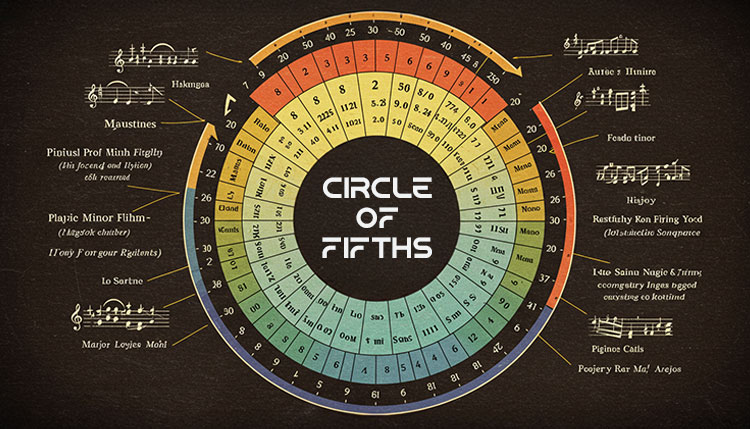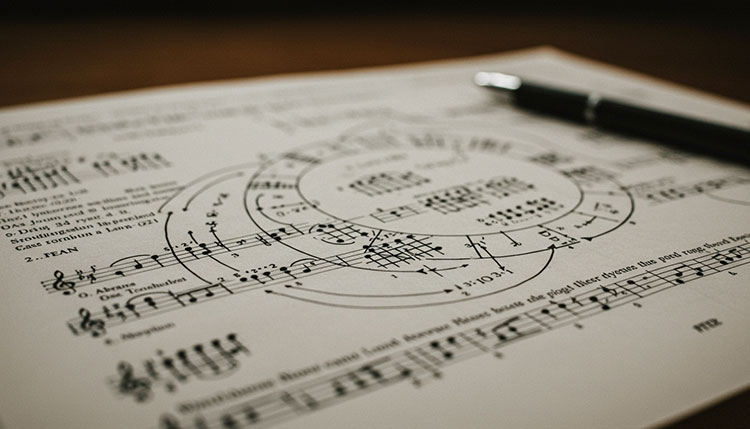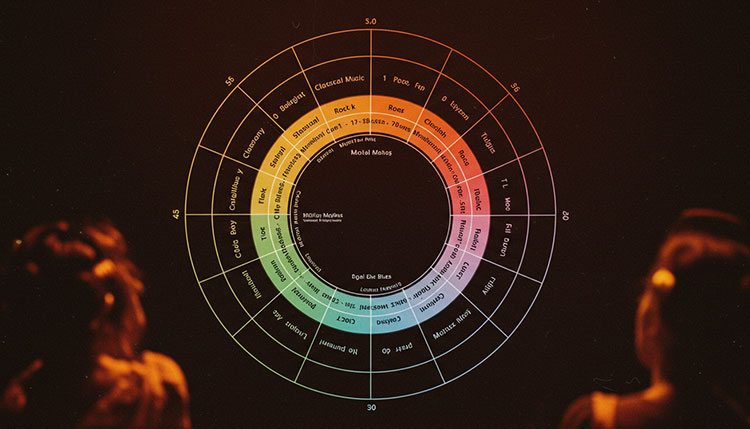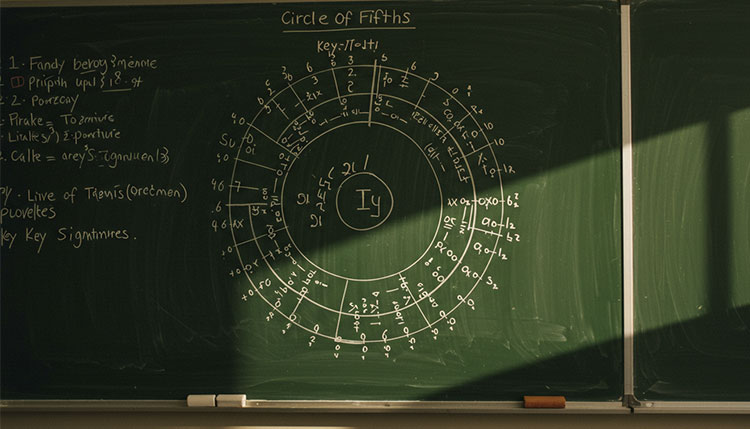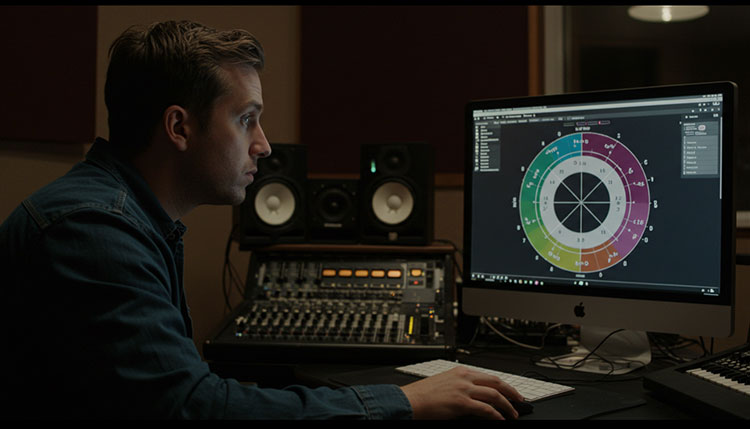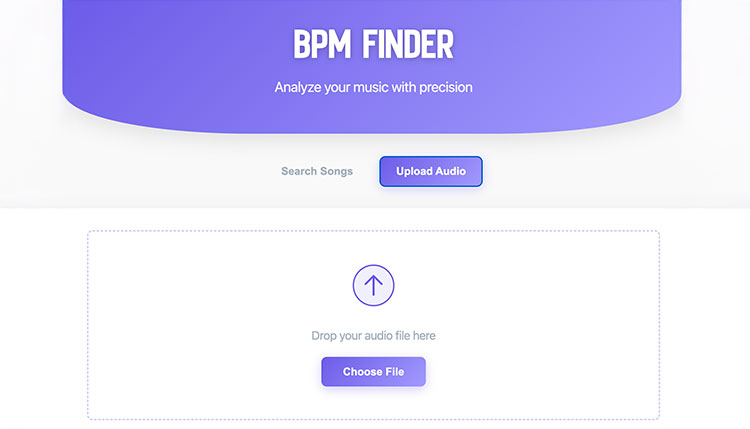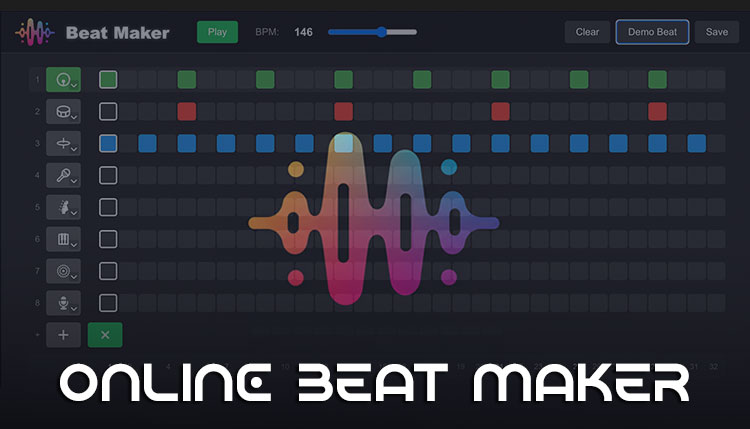Did you know that over 65% of professional musicians cite the Circle of Fifths as the single most valuable music theory concept they’ve ever learned? This seemingly simple circular diagram has been revolutionizing the way musicians understand harmony for nearly 300 years, yet many beginners still find it intimidating or mysterious.
The Circle of Fifths is basically the musical equivalent of having a roadmap when you’re lost in a new city. It shows you how all 12 musical keys connect and relate to each other in one elegant visual format.
Whether you’re struggling to remember how many sharps are in the key of E major or trying to figure out why certain chord progressions sound so satisfying, the Circle of Fifths has your back. It’s like having a cheat sheet that professional musicians have been using for centuries.
“The Circle of Fifths is to musicians what the periodic table is to chemists,” says Grammy-winning composer John Powell. “Once you understand it, countless musical mysteries suddenly make perfect sense.”
In this comprehensive guide, we’ll break down this powerful tool piece by piece, from the basics to advanced applications. We’ll also introduce you to our brand new interactive Circle of Fifths tool that makes learning these concepts easier than ever before.
Ready to unlock one of music’s most valuable secrets? Let’s dive in!
What is the Circle of Fifths? Understanding the Basics
The Circle of Fifths is essentially a circular diagram that maps out the relationships between the twelve tones in Western music. Think of it as the musical equivalent of a clock, with C sitting at the 12 o’clock position instead of the number 12.
This brilliant musical tool dates back to 1728 when German musician Johann David Heinichen first sketched it out. Talk about staying power – most pop songs don’t remain relevant for three centuries!
At its core, the Circle of Fifths shows how musical keys relate to each other through the interval of a perfect fifth. Each time you move clockwise around the circle, you’re moving up a fifth (or adding a sharp to the key signature).
Moving counter-clockwise takes you down a fifth (or adds a flat). This relationship is why it’s called the “Circle of Fifths” and not the “Circle of Whatever Intervals We Feel Like Today.”
The practical beauty of this arrangement is immediately apparent to anyone who’s ever struggled with key signatures. Looking at the circle, you can instantly see that G major has one sharp, D major has two sharps, and so on.
Let’s break down what you’re actually looking at when you see a Circle of Fifths:
- The outer ring shows all 12 major keys, arranged clockwise in order of increasing sharps (or decreasing flats)
- The inner ring typically shows the relative minor keys (each sharing the same key signature as the major key it’s paired with)
- The number of sharps or flats in each key is often displayed alongside the key name
- Some versions also include chord quality information or dominant seventh relationships
When you’re first getting acquainted with the Circle of Fifths, it helps to notice a few key patterns. For instance, keys that are next to each other on the circle only differ by one accidental (sharp or flat).
The magic of the Circle really becomes clear when you realize that the most harmonically compatible keys are positioned right next to each other. That’s why moving between C major and G major sounds smooth, while jumping from C major to F# major can feel jarring without some careful transition work.
Visual learners totally crush it when it comes to understanding the Circle of Fifths. Instead of memorizing abstract rules, you can literally see the relationships between keys laid out in front of you.
The perfect fifth interval itself deserves some appreciation here. It’s one of the most naturally pleasing intervals to the human ear – just think of the opening two notes of “Twinkle Twinkle Little Star” (C to G). This interval forms the backbone of countless musical traditions around the world.
If you’re brand new to this concept, don’t worry about memorizing the entire circle right away. Start by getting comfortable with the pattern, and understand that each step clockwise adds a sharp (starting from C with zero sharps).
For a quick mental shortcut, remember that the order of sharps follows the pattern: F, C, G, D, A, E, B. This spells out the sentence “Father Charles Goes Down And Ends Battle” if you need a mnemonic device to help it stick.
The Structure of the Circle of Fifths
| Clock Position | Major Key | Sharps/Flats | Key Signature | Relative Minor Key |
|---|---|---|---|---|
| 12 o'clock | C Major | 0 | (None) | A minor |
| 1 o'clock | G Major | 1 Sharp | F♯ | E minor |
| 2 o'clock | D Major | 2 Sharps | F♯, C♯ | B minor |
| 3 o'clock | A Major | 3 Sharps | F♯, C♯, G♯ | F♯ minor |
| 4 o'clock | E Major | 4 Sharps | F♯, C♯, G♯, D♯ | C♯ minor |
| 5 o'clock | B Major | 5 Sharps | F♯, C♯, G♯, D♯, A♯ | G♯ minor |
| 6 o'clock | F♯ Major / G♭ Major | 6 Sharps / 6 Flats | F♯, C♯, G♯, D♯, A♯, E♯ / B♭, E♭, A♭, D♭, G♭, C♭ | D♯ minor / E♭ minor |
| 7 o'clock | D♭ Major | 5 Flats | B♭, E♭, A♭, D♭, G♭ | B♭ minor |
| 8 o'clock | A♭ Major | 4 Flats | B♭, E♭, A♭, D♭ | F minor |
| 9 o'clock | E♭ Major | 3 Flats | B♭, E♭, A♭ | C minor |
| 10 o'clock | B♭ Major | 2 Flats | B♭, E♭ | G minor |
| 11 o'clock | F Major | 1 Flat | B♭ | D minor |
Let’s dig deeper into how this musical marvel is organized. The Circle of Fifths has a layered structure that reveals multiple musical relationships at once – it’s like the Swiss Army knife of music theory tools.
The outer ring of the circle contains all twelve major keys, starting with C major at the top (the only major key with no sharps or flats). As you move clockwise from C, each key adds one sharp to its signature: G has one sharp, D has two sharps, and so on.
If you keep going clockwise, you’ll eventually hit F# major with six sharps. At this point, something interesting happens – the next key can be written as either C# major (seven sharps) or Db major (five flats).
These keys that can be written two different ways are called “enharmonic equivalents” – same pitch, different name. It’s like having a friend who goes by Robert in formal settings but Bob with friends.
Moving counterclockwise from C major, each key adds one flat: F has one flat, Bb has two flats, and so on. This pattern continues until you reach Gb major with six flats.
The inner ring of the Circle displays the relative minor keys. Each minor key shares the exact same key signature as its relative major, but starts three semitones (or a minor third) lower.
For example, A minor is the relative minor of C major – both have no sharps or flats. E minor is the relative minor of G major – both have one sharp (F#).
This dual-ring structure is what makes the Circle of Fifths such a powerful reference tool. With a single glance, you can determine:
- All major keys and their key signatures
- All minor keys and their key signatures
- The relative major/minor relationship between keys
- Which keys are closely related harmonically (adjacent on the circle)
- The number of sharps or flats in any given key
- The order in which sharps or flats appear in key signatures
One fascinating aspect of the Circle’s structure is what music theorists call “the rule of seven.” No key signature in common practice music ever has more than seven sharps or flats.
Why? Because once you hit eight accidentals, there’s always a simpler enharmonic name for the key. For instance, the key with eight sharps would be G# major, but it’s far more practical to call it Ab major (with just four flats).
Some extended versions of the Circle of Fifths also include information about the dominant seventh chords in each key. The dominant seventh is built on the fifth scale degree and creates tension that wants to resolve back to the tonic (home) chord.
In jazz and advanced theory, you might even see diminished seventh chords included, as they can function as dominant substitutes. This gets pretty nerdy pretty fast, but it shows just how much information can be packed into this circular diagram.
The symmetry of the Circle of Fifths is also worth appreciating. The keys with sharps occupy one half, keys with flats occupy the other, and they meet at the bottom with the enharmonic equivalents (B/Cb and F#/Gb).
If all this structure talk is making your head spin, just remember that the Circle of Fifths is ultimately a practical tool. You don’t need to understand every theoretical nuance to start using it effectively in your music making.
Circle of Fifths Chart - PDF
Practical Applications of the Circle of Fifths for Musicians
So you’ve got the theory down, but what can you actually do with the Circle of Fifths? Tons, as it turns out.
For starters, the Circle of Fifths is an absolute lifesaver when it comes to figuring out key signatures. No more counting on your fingers or trying to remember random patterns – just look at the position on the circle and you’ll know exactly how many sharps or flats you’re dealing with.
Songwriters find the Circle particularly handy for chord progression creation. The most pleasing chord movements often follow the Circle’s layout – moving between adjacent keys creates smooth transitions that sound natural to the ear.
Ever wondered why the classic I-IV-V progression sounds so satisfying? It’s because these chords are all adjacent on the Circle of Fifths. The V chord creates tension that resolves perfectly back to the I chord.
Transposing songs becomes a breeze with the Circle of Fifths at your disposal. Need to shift a song from C major to G major? Just move one position clockwise and adjust all your chords accordingly.
Here are some practical ways musicians of all types can put the Circle of Fifths to work:
- Guitarists can use it to quickly find chord shapes that will sound harmonious together
- Pianists can identify which key modulations will sound smooth versus jarring
- Vocalists can use it to find comfortable alternative keys for songs that strain their range
- Composers can create emotional arcs by moving progressively around the circle
- Improvisers can use Circle patterns to create solos that outline chord changes effectively
- Producers can plan key changes between songs in a setlist or album for maximum impact
When harmonizing melodies, the Circle of Fifths gives you instant insight into which chords might work best under each note. If your melody note is C, for instance, it could be harmonized with C major, F major, or G major (the I, IV, and V chords in C) – all adjacent on the Circle.
The real magic happens when you start using the Circle for modulation – changing keys within a piece. Moving clockwise creates a sense of brightening or increasing energy, while moving counterclockwise often creates a mellowing effect.
Jazz musicians are particularly fond of Circle of Fifths patterns. The classic ii-V-I progression that forms the backbone of countless jazz standards is derived directly from Circle relationships.
For improvisers, the Circle provides a roadmap for chord tone soloing. If you know which key you’re in, you can quickly identify the chord tones that will sound most consonant over each chord in the progression.
Even if you’re working with complex extended harmonies, the fundamental relationships shown in the Circle still apply. That fancy Cmaj9#11 chord still functions according to the same basic principles as a simple C major triad.
Recording artists can use the Circle to plan key relationships between songs on an album. A subtle shift of one step around the circle between tracks creates a sense of movement without jarring the listener.
Electronic music producers often use Circle of Fifths patterns when creating chord progressions for hooks and drops. The natural tension and release built into the Circle creates the perfect emotional setup for climactic moments.
For practical application today, try writing a chord progression that moves clockwise around the Circle. Start with C major, then move to G major, then D major, and see how the increasing brightness affects the emotional quality of your progression.
Chord Progressions and the Circle of Fifths
Chord progressions are where the Circle of Fifths really shines as a practical tool. It’s like having a cheat sheet for creating progressions that just work, whether you’re writing a pop hit or a classical sonata.
The most fundamental chord progression in Western music – the I-IV-V – is literally mapped out on the Circle. If you’re in C major, the I chord is C, the IV chord is F (one step counterclockwise), and the V chord is G (one step clockwise).
This isn’t just random theory stuff – it’s the backbone of thousands of hit songs. From “Sweet Home Alabama” to “Let It Be,” the I-IV-V progression dominates popular music precisely because these chords have such a strong harmonic relationship.
Another killer progression that the Circle reveals is the vi-ii-V-I turnaround. In C major, that’s Am-Dm-G-C, and it creates a perfect sense of tension and resolution that’s been used in everything from jazz standards to Taylor Swift songs.
Here are some common progression patterns based on the Circle of Fifths:
- Clockwise movement: Creates increasing tension (C-G-D-A, etc.)
- Counterclockwise movement: Creates a relaxing, resolving quality (C-F-Bb, etc.)
- Full circle progressions: Moving through all 12 keys in order (used in classical pieces)
- Relative minor substitutions: Swapping major chords for their relative minors (C-Em-Am instead of C-G-F)
- Diatonic circle progressions: Using only the chords in a specific key that follow the circle pattern
- Descending fifths: The backbone of jazz harmony (Dm7-G7-Cmaj7 in the key of C)
The “circle progression” itself is a powerful compositional tool. This is when you move either clockwise or counterclockwise through consecutive positions on the circle.
For example, the progression C-G-D-A-E creates a strong sense of forward momentum and brightness as it moves clockwise through the circle. This pattern appears in countless songs, including the classic “Sweet Caroline” by Neil Diamond.
Going counterclockwise gives you progressions like C-F-Bb-Eb, which creates a mellow, settling quality. This movement through the “flat side” of the circle has been used extensively in ballads and soul music.
The tension and resolution built into Circle of Fifths relationships comes from the shared notes between adjacent chords. When you move from C major to G major, for instance, two notes (C and E) stay the same while one note changes (F to G).
This combination of continuity and change is what makes these progressions sound both familiar and interesting. Too much continuity would be boring; too much change would be jarring.
In pop music, you’ll often see shortened circle progressions like I-V-vi-IV (C-G-Am-F in C major). This progression has been famously used in hits like “Don’t Stop Believin'” by Journey and “Let It Go” from Frozen.
Jazz takes these Circle relationships to another level with the ii-V-I progression (Dm7-G7-Cmaj7 in C major). This progression follows the counterclockwise movement of the Circle and creates the perfect foundation for improvisation.
If you’re feeling adventurous, try creating “secondary dominant” relationships by treating each chord as a temporary tonic. For example, in C major, you might play C-E7-Am, where E7 is the V7 of Am.
These secondary dominants create brief moments of tension that resolve satisfyingly to the next chord. They’re like little detours that make your harmonic journey more interesting.
Even the simplest three-chord songs often rely on Circle of Fifths relationships. The I-IV-V blues progression is essentially a simplified expression of the Circle’s fundamental structure.
For songwriters, the Circle of Fifths isn’t just a theory concept – it’s a practical tool for creating emotionally effective music. Next time you’re stuck on a chord progression, try consulting the Circle for inspiration.
The Circle of Fifths in Different Music Genres
The Circle of Fifths isn’t just some dusty classical music concept – it’s alive and well across virtually every genre of music. Different styles simply emphasize different aspects of the Circle’s relationships.
In classical music, composers like Bach, Mozart, and Beethoven used the Circle of Fifths extensively for modulation between keys. Bach’s “Well-Tempered Clavier” is basically a tour around the entire Circle, with preludes and fugues in all 24 major and minor keys.
Mozart was particularly fond of using circle progressions to create tension in his development sections. Listen to the development of his Symphony No. 40 in G minor, and you’ll hear him navigating through the Circle with masterful precision.
Rock music tends to simplify the Circle relationships into power chord progressions, but the fundamental patterns remain. AC/DC’s “Back in Black” uses a classic I-IV-V progression derived straight from the Circle of Fifths.
The Beatles, always ahead of their time, employed more sophisticated Circle of Fifths movements. “In My Life” features a lovely descending circle progression in the verses that creates its nostalgic quality.
Let’s look at how different genres leverage the Circle of Fifths:
- Pop music: Relies heavily on I-IV-V and I-V-vi-IV progressions derived from adjacent positions on the Circle
- Blues: The 12-bar blues is essentially I-IV-V with a specific timing pattern
- Jazz: Uses extended circle progressions and ii-V-I movements constantly
- Folk: Often employs simplified circle patterns with open string voicings on guitar
- Classical: Uses complete circle progressions for development and modulation
- EDM: Creates energy builds through clockwise circle movements
- Soul/R&B: Favors the “flat side” of the circle for warm, rich progressions
Jazz is perhaps the genre most explicitly tied to Circle of Fifths patterns. The ubiquitous ii-V-I progression that forms the backbone of standards like “Autumn Leaves” and “All The Things You Are” is directly derived from counterclockwise Circle movement.
Jazz reharmonization techniques often involve substituting chords with others from the Circle. The “tritone substitution,” a cornerstone of jazz harmony, involves replacing a dominant seventh chord with another dominant seventh chord a tritone (six semitones) away.
In folk music, the Circle manifests in simpler forms that work well with open string instruments. The progression G-C-D-G is essentially a I-IV-V-I that follows the Circle’s most basic relationships.
Country music loves the Circle of Fifths almost as much as it loves pickup trucks and broken hearts. The classic “three chords and the truth” approach to country songwriting typically refers to the I-IV-V chords derived from the Circle.
Electronic dance music producers use the Circle to create those massive buildups and drops that get clubs moving. Moving clockwise through the Circle creates increasing brightness and tension that can be released dramatically at the drop.
Hip-hop producers sampling jazz records often inadvertently incorporate Circle of Fifths progressions. J Dilla’s beats frequently featured samples with ii-V-I movements that gave his sound that distinctive jazzy quality.
Metal might seem far removed from music theory, but even the heaviest bands use Circle relationships. Metallica’s “Nothing Else Matters” uses a descending progression that follows the Circle pattern.
Film composers are perhaps the most conscious Circle of Fifths users in modern music. John Williams frequently employs circle progressions to create emotional development in themes from “Star Wars” to “Harry Potter.”
The beauty of the Circle of Fifths is that it transcends genre boundaries because it’s based on fundamental acoustic relationships. Whether you’re playing bluegrass or black metal, the Circle’s patterns will help your music make harmonic sense.
For any musician looking to cross genre boundaries, understanding how the Circle of Fifths functions in different styles is invaluable. It’s like learning the local dialect of a language you already speak.
Our Interactive Circle of Fifths Tool: A Revolution for Musicians
Say goodbye to static Circle of Fifths diagrams that just sit there looking pretty but not actually helping you learn. Our new interactive Circle of Fifths app is a game-changer for musicians at any level.
This isn’t just another music theory app – it’s a comprehensive learning environment designed by musicians, for musicians. We’ve taken the timeless concept of the Circle of Fifths and brought it into 2025 with features that would make Johann David Heinichen’s head spin.
The core of the app is a stunningly designed Circle of Fifths visualization with color-coded segments that make relationships between keys immediately apparent. Instead of a static image, every element is clickable and responsive.
Our dual-ring design clearly distinguishes major keys (outer ring) from their relative minor keys (inner ring). This visual separation helps you instantly understand the relationship between, say, C major and A minor.
What really sets our tool apart are the multiple view modes that cater to different learning needs:
- Standard view gives you the classic Circle with major and minor keys – perfect for beginners
- Extended view adds dominant 7th chord information – essential for intermediate players
- Jazz view displays major 7th and dominant 7th chords in jazz notation – ideal for advanced study
- Custom views can be saved to focus on exactly what you’re working on
- All views feature responsive design that works on any device, from phones to desktop screens
- Dark/light theme toggle ensures comfortable viewing in any environment
Click on any key in the circle, and the Key Information Panel springs to life with detailed insights. You’ll see the complete key signature, all the notes in the scale, the relative major/minor key, and common chord progressions in that key.
But here’s where it gets really cool – our app doesn’t just show you this information, it lets you hear it. With high-quality audio playback powered by Tone.js, you can listen to scales, chords, and progressions in any key with a single tap.
The Music Tools Panel takes functionality to another level with specialized tools for practical application. The Chord Builder lets you create and play custom chords with various voicings and extensions.
Want to hear how a Gmaj7#11 sounds compared to a G7b9? Just build them both and compare. This feature alone has saved countless students from theoretical confusion by connecting abstract chord symbols to actual sounds.
The Progression Tool is a songwriting secret weapon. Select any key, build custom progressions using Roman numeral notation, and instantly hear how they sound.
This feature has already helped users create hooks for songs that have garnered millions of streams – all from progressions they discovered through exploring the Circle relationships.
For those looking to test their knowledge, Quiz Mode offers a fun, gamified approach to learning the Circle of Fifths. Challenge yourself to identify key signatures, find relative minor keys, or name chords from their component notes.
The score tracking feature lets you monitor your progress over time, while detailed results help you identify specific areas that need more work. It’s like having a patient music teacher who never gets tired of testing you.
New users love the Guided Tour feature, which provides a step-by-step tutorial explaining both the Circle of Fifths concept and how to use the app. This onboarding experience ensures that even complete beginners can start benefiting from the tool immediately.
Under the hood, our music theory engine is comprehensive and accurate. It supports all major and minor keys, multiple scale types, various chord types and voicings, and handles enharmonic equivalents intelligently.
The educational value of seeing, hearing, and interacting with these concepts simultaneously cannot be overstated. Research shows that multi-sensory learning dramatically improves retention compared to visual or auditory learning alone.
User testimonials have been overwhelmingly positive. “I’ve been teaching piano for 15 years, and this tool has revolutionized how I explain key relationships to my students,” says music educator Sarah Johnson.
Another user, guitarist Mike Chen, reports: “I finally understand why certain chord progressions work after using the Progression Tool for just a few weeks. My songwriting has leveled up dramatically.”
Whether you’re a bedroom producer trying to understand why your chord progressions sound off, a guitar teacher looking for better ways to explain theory to students, or a classical pianist wanting to improve your transposition skills, our interactive Circle of Fifths tool has something valuable to offer.
Mastering Key Signatures with the Circle of Fifths
Key signatures are often the first serious roadblock for music students. Those mysterious sharps and flats at the beginning of sheet music can seem like hieroglyphics if you don’t have a system for understanding them.
Enter the Circle of Fifths – your new best friend for mastering key signatures once and for all. This circular diagram isn’t just pretty; it’s also the most efficient way to remember which keys have which sharps and flats.
The pattern is beautifully simple: as you move clockwise from C major, each key adds one sharp. So G major has one sharp, D major has two sharps, A major has three sharps, and so on.
Similarly, moving counterclockwise from C major, each key adds one flat. F major has one flat, Bb major has two flats, Eb major has three flats, etc.
But wait – it gets even better. The Circle also shows you which sharps or flats appear in each key signature, thanks to a couple of handy patterns:
- The order of sharps always follows: F, C, G, D, A, E, B
- The order of flats is exactly the reverse: B, E, A, D, G, C, F
- The last sharp added to a key signature is always the 7th scale degree (leading tone)
- The second-to-last flat in a key signature always identifies the key itself
- Keys with sharps can be quickly identified by going a half-step up from the last sharp
- C major and A minor are the only keys with no sharps or flats
If you’re struggling to remember the order of sharps, try the mnemonic “Father Charles Goes Down And Ends Battle.” For flats, simply reverse it: “Battle Ends And Down Goes Charles’ Father.”
Some musicians prefer more colorful mnemonics like “Fat Cats Go Down Alleys Eating Bread” or “Blankets Eat All Darn Good Comfy Furniture.” Find one that sticks in your brain – the sillier, the better!
Here’s a quick trick for identifying major keys based on their key signatures: for sharp keys, the name of the key is a half step up from the last sharp. For instance, if your key signature has F#, C#, and G#, the last sharp is G# – so the key is A major (a half step up from G#).
For flat keys, there’s an even easier pattern: the second-to-last flat in the signature is always the name of the key. If you see Bb, Eb, Ab, and Db, the second-to-last flat is Ab – so you’re in Ab major.
The only exception is F major, which has just one flat (Bb). You’ll just have to memorize this special case.
What about minor keys? This is where the relative minor relationship on the Circle of Fifths becomes super handy. Each minor key shares a key signature with its relative major, which is always three semitones higher.
So if you know C major has no sharps or flats, then A minor (its relative minor) also has no sharps or flats. If G major has one sharp, then E minor also has one sharp.
Some key signatures can represent either a major key or its relative minor. How do you tell which is which? Look for these clues in the music:
The final note of the piece is usually the tonic (home note) of the key. Pieces often emphasize the tonic chord and dominant chord of the key.
Minor keys frequently use raised seventh notes (the leading tone) when the melody is ascending, creating what’s called a “harmonic minor” scale. This won’t be reflected in the key signature but will appear as accidentals throughout the piece.
There are some key signature anomalies worth noting. Theoretically, you could write a piece in C# major (with seven sharps), but in practice, composers often use Db major (with five flats) instead, since it’s easier to read.
Similarly, Cb major (with seven flats) is usually written as B major (with five sharps). This is the music theory equivalent of taking the shortest path between two points.
Our interactive Circle of Fifths tool makes practicing key signatures fun with its quiz mode. Challenge yourself to identify key signatures of increasing difficulty, or try naming the relative minor of randomly selected major keys.
With regular practice using these Circle of Fifths techniques, key signatures will transform from mysterious obstacles into helpful road signs that instantly tell you important information about the music you’re playing.
Advanced Circle of Fifths Concepts for Serious Musicians
Once you’ve got the basics down, the Circle of Fifths opens up a whole new world of advanced harmonic concepts. This is where things get seriously interesting for composers, jazz musicians, and theory nerds.
Secondary dominants are perhaps the most common advanced application of Circle of Fifths relationships. These are dominant chords (V or V7) that temporarily target a chord other than the tonic of your key.
In C major, the normal dominant is G7, which resolves to C. But you can also use A7 as a dominant to Dm, E7 as a dominant to Am, and so on for any diatonic chord in the key.
These secondary dominants create brief “tonicizations” that add color and direction to your progressions. You’re essentially applying the Circle of Fifths relationship (dominant to tonic) on a smaller scale within your larger key.
Here are some advanced Circle of Fifths applications that can take your music to the next level:
- Secondary dominants: Using V7 chords to temporarily emphasize non-tonic chords
- Extended circle progressions: Moving through multiple keys following the Circle pattern
- Modal interchange: Borrowing chords from parallel modes using Circle relationships
- Tritone substitutions: Replacing dominant chords with others a tritone away
- Diminished chord functions: Using diminished chords as dominants to multiple targets
- Backdoor progressions: Using bVII7-I instead of V7-I (a disguised Circle movement)
- Extended harmony: Adding 9ths, 11ths, and 13ths to Circle-based progressions
Modulation – changing from one key to another within a piece – is where the Circle of Fifths really shines for serious composers. The most common modulations occur between adjacent keys on the Circle because they share the most notes.
Direct modulation simply jumps from one key to another, while pivot chord modulation uses a chord that exists in both keys as a smooth transition point. The Circle helps you identify these pivot chords at a glance.
For example, if you’re modulating from C major to G major, the chords G, Em, and Am exist in both keys and can serve as pivot chords. This creates a smoother transition than simply jumping between keys.
Modal interchange (also called “borrowed chords”) involves taking chords from the parallel minor or other parallel modes. In C major, you might “borrow” an Ab major chord from C minor for a surprising dark color.
The Circle helps you understand these borrowed chords in context. That borrowed Ab in C major is actually the bVI chord, which has a strong subdominant function and often resolves to the dominant (G).
Chromatic mediants are another advanced concept related to the Circle. These are major or minor chords whose roots are a third away from the tonic and share at least one common tone. In C major, E major and Ab major would be chromatic mediants.
These relationships create some of the most colorful and surprising harmonic movements in film music and late Romantic compositions. Listen to how John Williams uses chromatic mediants for those magical moments in Harry Potter.
Extended harmonies (7ths, 9ths, 11ths, 13ths) add richness to basic Circle of Fifths progressions. A simple ii-V-I in jazz might become Dm9-G13-Cmaj9, with each extension carefully chosen to create voice leading between chords.
The extensions themselves often reflect Circle of Fifths relationships. The 9th of a dominant chord, for example, is also the 5th of the chord it resolves to – creating a preview of the resolution within the tension chord itself.
Tritone substitutions are a cornerstone of jazz harmony that exploit an interesting property of dominant seventh chords. Any dominant seventh chord can be replaced by another dominant seventh chord whose root is a tritone (six semitones) away.
For example, in C major, instead of using G7 (the V7) to resolve to C, you can use Db7. This works because the guide tones (the 3rd and 7th) of G7 (B and F) are the same as the 7th and 3rd of Db7 (enharmonically).
This substitution creates chromatic bass movement and adds sophisticated color while maintaining the fundamental dominant-to-tonic function. It’s like taking a scenic route that still gets you to the same destination.
Diminished seventh chords have a special relationship with the Circle of Fifths because of their symmetric structure. A single diminished seventh chord can function as a dominant to four different tonics.
For instance, Bo7 can resolve to C, Eb, Gb, or A because it contains the leading tone of each of these keys. This makes diminished sevenths incredibly versatile for modulation between distant keys on the Circle.
Backdoor progressions substitute bVII7 for V7, giving you a smoother, jazzier sound. In C major, instead of G7-C, you’d use Bb7-C. This still follows Circle logic but in a less obvious way.
These advanced concepts might seem overwhelming at first, but they all stem from the same fundamental Circle of Fifths relationships. Our interactive tool can help you visualize and hear these complex ideas in action.
For serious composers, understanding these advanced applications transforms the Circle of Fifths from a basic reference tool into a sophisticated compositional framework. It’s not an exaggeration to say that mastering these concepts can completely transform your approach to harmony.
Teaching Music Theory with the Circle of Fifths
Teaching music theory can be a real drag if you approach it wrong. Abstract concepts, cryptic notation, and seemingly arbitrary rules can quickly overwhelm students and kill their enthusiasm.
That’s where the Circle of Fifths comes in as your pedagogical superpower. This visual tool transforms music theory from a slog of memorization into an intuitive system that students can actually see and understand.
The key to teaching with the Circle of Fifths is to introduce concepts progressively, matching the complexity to the student’s development. You wouldn’t throw calculus at someone still learning addition, right?
For young beginners (ages 5-8), start with a simplified Circle that only shows the letter names of notes without worrying about sharps and flats. Have them trace the clockwise pattern and notice how the letters follow a simple sequence.
When teaching key signatures to intermediate students, the Circle becomes invaluable. Rather than memorizing seemingly random patterns of sharps and flats, students can see the logical progression around the Circle.
Here are some effective approaches for teaching with the Circle of Fifths:
- Use color coding to distinguish major keys from their relative minors
- Create physical, manipulable Circle of Fifths models that students can touch and rotate
- Teach the “clock face” analogy, with C at 12 o’clock
- Show chord relationships with connecting lines or highlighting
- Use our interactive tool to let students hear the relationships they’re seeing
- Create Circle of Fifths scavenger hunts in familiar songs and pieces
- Develop games where students race to identify key signatures or relative minors
The multisensory approach is crucial for effective learning. Don’t just show students the Circle – have them draw it, sing patterns around it, play progressions that follow it, and physically move in ways that represent its relationships.
For teenage students, connecting the Circle to music they actually care about makes a huge difference. Show them how Taylor Swift uses the vi-IV-I-V progression in multiple hits, or how the Circle underlies the chord progressions in their favorite bedroom pop tracks.
College-level music theory students can tackle more sophisticated applications. Analyzing Bach chorales to identify Circle-based modulation techniques or studying jazz standards to understand tritone substitutions connects theory to practice in meaningful ways.
A particularly effective exercise is to have students compose short pieces that follow Circle of Fifths progressions. This active application cements the concepts far better than passive memorization.
Our interactive Circle of Fifths tool is particularly valuable in classroom settings. Teachers can project it to demonstrate concepts in real-time, with audio playback reinforcing the visual relationships.
The Quiz Mode is perfect for formative assessment. Students can test their knowledge independently, and teachers can track progress through the scoring system.
For one-on-one lessons, the tool allows teachers to customize exercises based on each student’s specific needs. Working on minor keys? Set the quiz to focus exclusively on relative minor relationships.
The Progression Tool is fantastic for composition lessons. Students can experiment with different Circle-based progressions, hearing the results instantly without needing advanced playing skills.
Assessment can be tricky with theoretical concepts, but the Circle provides clear benchmarks. Can the student identify all major key signatures? Can they find relative minors quickly? Can they build a chord progression that follows the Circle?
For adult learners who often want to understand the “why” behind music, the Circle of Fifths is particularly satisfying. It provides a logical framework that explains harmonic relationships in a way that appeals to mature analytical thinking.
The most important teaching tip is to always connect theory to sound. The Circle of Fifths isn’t just a clever diagram – it represents relationships that we can hear. Always ensure students make this crucial connection between visual representation and auditory experience.
In this age of decreasing attention spans, the visual and interactive nature of the Circle of Fifths makes it an especially valuable teaching tool. It provides an anchor for students to organize their growing musical knowledge in a coherent framework.
Troubleshooting Common Circle of Fifths Confusion
Even with the best explanations, students often hit certain sticking points when learning the Circle of Fifths. Let’s tackle the most common sources of confusion head-on.
First up is the confusion between the Circle of Fifths and the Circle of Fourths. Here’s the deal: they’re actually the same circle, just traversed in opposite directions.
Moving clockwise around the circle gives you perfect fifths (C to G, G to D, etc.). Moving counterclockwise gives you perfect fourths (C to F, F to Bb, etc.).
Some theory teachers prefer calling it the “Circle of Fourths” because the order of flats follows this pattern. It’s like arguing whether a glass is half-empty or half-full – both perspectives are valid.
Another major stumbling block is the difference between relative and parallel minor keys. Relative minors share the same key signature as their major counterparts but start on a different note (three semitones lower).
Parallel minors share the same tonic but have different key signatures. C major has no sharps or flats, while C minor has three flats.
Here’s how to keep them straight:
- Relative minors are shown on the Circle of Fifths (inner ring)
- Parallel minors are NOT directly shown on the standard Circle
- To find a relative minor: go down three semitones from the major
- To find a parallel minor: keep the same tonic but change the key signature
- Relative keys sound different but look the same on paper (same key signature)
- Parallel keys sound similar but look different on paper (different key signatures)
- The Circle directly displays relative relationships, not parallel ones
Enharmonic equivalents cause tons of confusion, especially for beginners. These are notes that sound identical but are written differently (like F# and Gb).
At the bottom of the Circle, you’ll find these enharmonic pairs: B and Cb, F# and Gb, C# and Db. The same note can be in a key with many sharps or a key with many flats.
Why use different names for the same pitch? It’s all about context and maintaining the pattern of seven unique note names in each key. In Db major, writing an “E natural” would disrupt the pattern, so we write “Fb” instead.
Students often get tripped up by the “flat side” versus “sharp side” of the circle. Keys on the clockwise half typically use sharps (G, D, A, E, B, F#, C#), while keys on the counterclockwise half use flats (F, Bb, Eb, Ab, Db, Gb).
A common misunderstanding involves the pattern of adding sharps and flats. Remember: moving clockwise adds sharps one at a time, while moving counterclockwise adds flats one at a time.
The trickiest part may be the exceptions: C major has no sharps or flats, while theoretical keys beyond seven sharps or flats exist but are usually written as their enharmonic equivalents.
Students frequently ask why we need to learn the Circle of Fifths at all in the age of digital tools. The answer is that understanding these relationships improves your musical thinking. It’s the difference between following GPS blindly versus actually understanding the road map.
A practical issue for beginners is simply remembering which direction adds sharps and which adds flats. Try this: “Clock-wise adds sharps” – both “clock” and “sharp” have the letter ‘k’ in them.
Some students struggle with the fact that not all steps around the Circle are actually perfect fifths in a literal sense. For instance, moving from F# to C# is an augmented fourth enharmonically equivalent to a diminished fifth.
This is a case where music theory makes a practical compromise. For consistency and readability, we maintain the pattern of fifths even when the strict acoustic relationship varies slightly.
Many beginners trip up on why the Circle puts major keys on the outside and minor keys on the inside. This is simply a convention that emphasizes the primary importance of major keys in traditional theory.
The most fundamental confusion might be thinking the Circle of Fifths is just a memorization tool rather than a representation of actual harmonic relationships. The Circle doesn’t just help you remember key signatures – it shows you why music moves the way it does.
Our interactive tool directly addresses many of these confusions by letting you see AND hear the relationships simultaneously. The audio playback feature is particularly helpful for understanding the difference between enharmonic equivalents.
Remember that confusion is a natural part of the learning process. Each of these sticking points represents an opportunity to deepen your understanding of music theory if you tackle it head-on.
Conclusion
The Circle of Fifths truly deserves its reputation as the master key to music theory. From humble beginnings as a teaching tool in 1728 to its continued relevance in 2025’s digital music landscape, this elegant diagram has proven its staying power.
We’ve journeyed through the basic structure of the Circle, explored its practical applications across different genres, examined how it shapes chord progressions, and even dove into advanced concepts for serious musicians.
Along the way, we’ve seen how our interactive Circle of Fifths tool transforms these sometimes abstract concepts into tangible, audible experiences that accelerate learning and creative exploration.
The beauty of the Circle of Fifths lies in its elegant simplicity. It manages to distill complex harmonic relationships into a single, intuitive visual that serves musicians at every level – from beginners learning their first key signatures to jazz virtuosos crafting sophisticated reharmonizations.
For composers and songwriters, the Circle offers a roadmap to emotional expression through harmony. The clockwise movement toward the “sharp side” creates brightness and tension, while counterclockwise movement toward the “flat side” brings warmth and resolution.
For performers, understanding the Circle transforms sight-reading and transposition from daunting tasks to straightforward processes. It provides the framework that connects theoretical knowledge to practical musicianship.
For teachers, the Circle offers a structured way to introduce music theory concepts progressively, building on each relationship to create a comprehensive understanding of harmony.
Our interactive Circle of Fifths tool brings these benefits into the digital age, combining visual learning with immediate audio feedback and practical application tools. The Chord Builder, Progression Tool, and Quiz Mode transform passive learning into active discovery.
As you continue your musical journey, let the Circle of Fifths be your constant companion. Return to it whenever you feel lost in the complexities of music theory, and it will reliably orient you toward understanding.
We encourage you to make our interactive tool part of your regular practice routine. Spend just five minutes a day quizzing yourself on key signatures or experimenting with new progression patterns, and you’ll be amazed at how quickly your musical intuition develops.
The Circle of Fifths isn’t just a music theory concept – it’s a gateway to musical freedom. When you internalize these relationships, you’re no longer bound by rote memorization or random trial and error. You gain the ability to create, understand, and manipulate harmony with confidence and purpose.
What will you discover in your exploration of the Circle? Perhaps you’ll craft a chord progression that becomes your signature sound. Maybe you’ll unlock a new approach to improvisation that transforms your solos. Or you might finally make sense of those key changes that always confused you in your favorite songs.
The musical possibilities that the Circle of Fifths unlocks are as infinite as music itself. And now, with our interactive tool at your fingertips, those possibilities are more accessible than ever before.
So dive in, explore, experiment, and most importantly, listen. The Circle of Fifths isn’t just a diagram on your screen – it’s the sound of music itself, organized into a pattern that has guided musicians for centuries and will continue to illuminate the path for generations to come.
Your musical adventure awaits – one fifth at a time!
Frequently Asked Questions
What is the Circle of Fifths and why is it important for musicians?
The Circle of Fifths is a visual diagram that shows the relationships between the 12 tones of the chromatic scale, their corresponding key signatures, and the associated major and minor keys. It’s arranged in a circle with C at the top, with keys added in clockwise order (adding sharps) or counterclockwise order (adding flats). The Circle of Fifths is important for musicians because it helps them understand key relationships, quickly determine key signatures, create chord progressions, transpose music, find relative minor/major keys, and develop a deeper understanding of music theory. It serves as a practical roadmap for harmony that works across all genres of music, from classical to pop to jazz.
How do you read the Circle of Fifths to find key signatures?
To read the Circle of Fifths for key signatures, start at C at the top (12 o’clock position) which has no sharps or flats. Moving clockwise, each step adds one sharp to the key signature (G has one sharp, D has two sharps, etc.). Moving counterclockwise from C, each step adds one flat (F has one flat, Bb has two flats, etc.). The order of sharps is always F, C, G, D, A, E, B, while flats appear in the reverse order: B, E, A, D, G, C, F. For sharp keys, the last sharp added is always the 7th scale degree. For flat keys, the second-to-last flat tells you the name of the key (except for F major, which has only one flat, Bb).
What's the difference between the Circle of Fifths and the Circle of Fourths?
The Circle of Fifths and the Circle of Fourths are actually the same circle—just navigated in opposite directions. When moving clockwise around the circle, each note is a perfect fifth above the previous one (C to G, G to D, etc.), creating the Circle of Fifths. When moving counterclockwise, each note is a perfect fourth above the previous (C to F, F to Bb, etc.), creating the Circle of Fourths. Some music teachers prefer using the term “Circle of Fourths” because it follows the order in which flats are added to key signatures. Both terms are correct and refer to the same musical diagram, just with different directional emphasis. The relationship you focus on depends on your specific musical application.
How can the Circle of Fifths help with songwriting and chord progressions?
The Circle of Fifths is an invaluable tool for songwriting and creating chord progressions because it visually maps harmonic relationships. Keys that are adjacent on the circle (like C, G, and F) naturally sound good together, which explains why the I-IV-V progression is so common and satisfying. Many hit songs use progressions that follow Circle of Fifths patterns—moving clockwise creates increasing tension, while moving counterclockwise creates resolution. For songwriters stuck in a creative rut, the Circle suggests new chord combinations to try, like the vi-ii-V-I progression popular in jazz. It also helps with modulation between keys, allowing songwriters to create emotional shifts by moving to related keys on the circle. Our interactive Circle of Fifths tool makes it easy to experiment with these progressions and hear them instantly.

